With more and more mobile punters accessing the web to download music, watch video, browse the web or grab emails, Nokia are hoping to persuade some wallets to creak open for their new 6120 classic phone offering the faster HSDPA (High Speed Downlink Packet Access) connectivity.
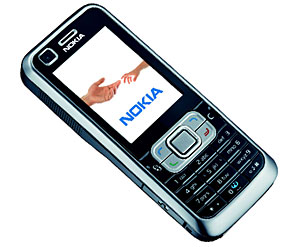 Claimed to offer downloads “up to 10 times faster than over usual WCDMA networks,” the Nokia 6120 bigs up its multimedia credentials sporting two cameras. The first is a basic, low res affair slapped on the front for video calls, while the main camera serves up 2-megapixels worth of picture-grabbing, 4-times digital zoom, a built in flash and a panorama mode.
Claimed to offer downloads “up to 10 times faster than over usual WCDMA networks,” the Nokia 6120 bigs up its multimedia credentials sporting two cameras. The first is a basic, low res affair slapped on the front for video calls, while the main camera serves up 2-megapixels worth of picture-grabbing, 4-times digital zoom, a built in flash and a panorama mode.
Powered by a Symbian Series 60 OS, the 6120 looks very similar to its slower 3G predecessor, the 6233, with all the gubbins enclosed in Nokia’s familiar candybar form factor and a bright QVGA-quality display with 16-million colours dominating the front.
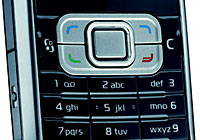 There’s Bluetooth on board for wireless streaming of stereo sounds, a built-in FM radio, support for MP3/AAC/MPEG4 tuneage and a micro SD card slot for slapping in some more memory capacity.
There’s Bluetooth on board for wireless streaming of stereo sounds, a built-in FM radio, support for MP3/AAC/MPEG4 tuneage and a micro SD card slot for slapping in some more memory capacity.
To help fumbling newbies and floundering technophobes, the 6120 comes with bundled How-To Guides and a Set-up Wizard for setting up email, messaging and Internet connection, with Data Transfer apps helping users shuffle all their contacts, calendars, photos, videos and files over from their old Nokia handset.
With the phone purring along on the S60 OS, there’s ample scope for users to download third party apps and customise the phone to their heart’s desire.
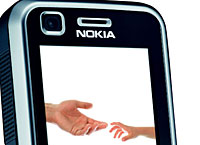 Here’s Peter Ropke, Senior Vice President, Mobile Phones, Nokia to whip us into a frenzy of expectation for the phone, “With the HSDPA technology, S60 operating system and the wide range of features of the Nokia 6120 classic, consumers will be able to make their daily lives more manageable.”
Here’s Peter Ropke, Senior Vice President, Mobile Phones, Nokia to whip us into a frenzy of expectation for the phone, “With the HSDPA technology, S60 operating system and the wide range of features of the Nokia 6120 classic, consumers will be able to make their daily lives more manageable.”
The Nokia 6120 classic (no relation to the 6120 they released in the 1998!) should start shimmying on to shop shelves in the summer for around 260 Euros (around £175) SIM-free.
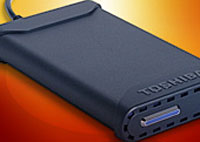 With its feeble 1.44MB storage space, that often meant you had to cart around great boxes of the things.
With its feeble 1.44MB storage space, that often meant you had to cart around great boxes of the things. With this in mind, Toshiba – the world’s fifth-largest hard drive manufacturer – has decided to elbow its way into the portable drive market with its 2.5-inch USB 2.0 portable external hard drive offering a positively palatial 200GB of storage space. That works out at 57,000 digital photos, 52,000 MP3 songs or 88 DVD videos all wedged into its slimline case (approx 6″x4″x0.9″).
With this in mind, Toshiba – the world’s fifth-largest hard drive manufacturer – has decided to elbow its way into the portable drive market with its 2.5-inch USB 2.0 portable external hard drive offering a positively palatial 200GB of storage space. That works out at 57,000 digital photos, 52,000 MP3 songs or 88 DVD videos all wedged into its slimline case (approx 6″x4″x0.9″). Intel is getting ready to release its own version of the mini-tablet, with
Intel is getting ready to release its own version of the mini-tablet, with 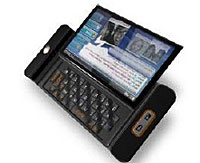 Expected to be released next year, the UMPCs are tipped to be an extension of the successful Centrino mobile brand, with the CPU components (codenamed Stealey) packing dual-core processors clocked at 600-800MHz.
Expected to be released next year, the UMPCs are tipped to be an extension of the successful Centrino mobile brand, with the CPU components (codenamed Stealey) packing dual-core processors clocked at 600-800MHz.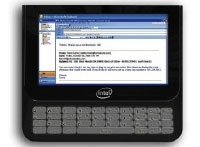 Intel’s new gizmo is looking to woo punters with a seductive mobile mix of email, web, entertainment, information and location-based services, including the trusty Google Maps application and Web-based “office and enterprise applications.”
Intel’s new gizmo is looking to woo punters with a seductive mobile mix of email, web, entertainment, information and location-based services, including the trusty Google Maps application and Web-based “office and enterprise applications.”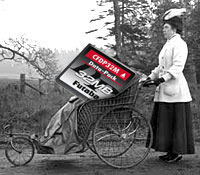 The two companies have revealed details about their Memorandum of Understanding (MOU) to develop a new SxS memory card format for professional camcorders.
The two companies have revealed details about their Memorandum of Understanding (MOU) to develop a new SxS memory card format for professional camcorders. Although the card is too much of a heffalump to fit into digital compact cameras, it may appear in some high end medium format still cameras and other specialised snappers.
Although the card is too much of a heffalump to fit into digital compact cameras, it may appear in some high end medium format still cameras and other specialised snappers.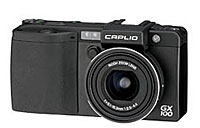 Never a company to run with the pack, the new Ricoh Caplio GX100 serves up an innovative feature set, with a super wide 24 to 72 mm wide zoom lens (35mm film equivalent), a fast F2.5 aperture and 10.01 Megapixel CCD sensor.
Never a company to run with the pack, the new Ricoh Caplio GX100 serves up an innovative feature set, with a super wide 24 to 72 mm wide zoom lens (35mm film equivalent), a fast F2.5 aperture and 10.01 Megapixel CCD sensor.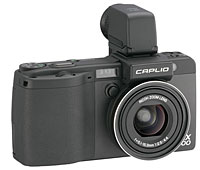 Another innovation that has set photo-nerd hearts a-fluttering in Chez Digi Lifestyles is the optional removable electronic viewfinder.
Another innovation that has set photo-nerd hearts a-fluttering in Chez Digi Lifestyles is the optional removable electronic viewfinder.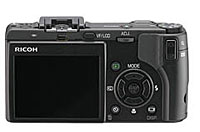 As with the GR, macro focussing goes all the way down to a frankly ridiculous 1 cm (any closer and you’ll be burrowing into the subject), with a built in CCD shift method offering vibration reduction.
As with the GR, macro focussing goes all the way down to a frankly ridiculous 1 cm (any closer and you’ll be burrowing into the subject), with a built in CCD shift method offering vibration reduction.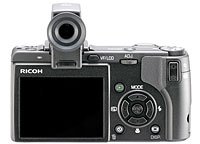 With the Ricoh Caplio GX100 measuring up at just 25mm, this looks to be a great carry everywhere camera, and with a claimed battery life of 380 exposures, this looks to be a very, very interesting camera.
With the Ricoh Caplio GX100 measuring up at just 25mm, this looks to be a great carry everywhere camera, and with a claimed battery life of 380 exposures, this looks to be a very, very interesting camera. Memory SD Memory Card ( 32, 64, 128, 256, 512 MB, 1, 2 GB), SDHC Memory Card (4 GB),
Memory SD Memory Card ( 32, 64, 128, 256, 512 MB, 1, 2 GB), SDHC Memory Card (4 GB),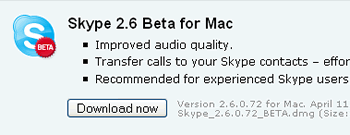 While they’ve been tightening out various bits and pieces, they’ve launched an important new feature, Call Transfer on the Mac first, going against the other Skype releases that have dragged behind the PC.
While they’ve been tightening out various bits and pieces, they’ve launched an important new feature, Call Transfer on the Mac first, going against the other Skype releases that have dragged behind the PC.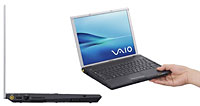 Previously released as a featherweight 2.1 pounds laptop sporting a 40/80GB hard drive and 12.1 inch display, Sony have just cranked up the VAIO’s desirability rating to wanton craving with the news of a 32GB Solid State Disk option.
Previously released as a featherweight 2.1 pounds laptop sporting a 40/80GB hard drive and 12.1 inch display, Sony have just cranked up the VAIO’s desirability rating to wanton craving with the news of a 32GB Solid State Disk option.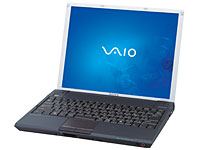 Without a hard drove rattling away inside, the standard battery life has been extended by half an hour, giving a very generous 6.5 hours in total. Users investing in the longlife ‘L’ battery can enjoy a battery life that will leave even the Duracell bunny in need of a fag and lie down, with Sony claiming a whopping 12.5 hours of use.
Without a hard drove rattling away inside, the standard battery life has been extended by half an hour, giving a very generous 6.5 hours in total. Users investing in the longlife ‘L’ battery can enjoy a battery life that will leave even the Duracell bunny in need of a fag and lie down, with Sony claiming a whopping 12.5 hours of use.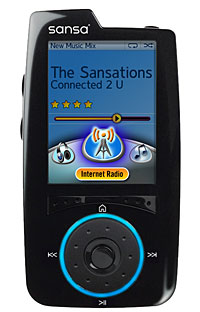 After connecting the Sansa Connect media player to the Internet via Wi-Fi, users will be able to listen to LAUNCHcast Internet radio, rummage through Flickr photos and check out what Yahoo Messenger friends and nearby Sansa Connect owners are grooving to.
After connecting the Sansa Connect media player to the Internet via Wi-Fi, users will be able to listen to LAUNCHcast Internet radio, rummage through Flickr photos and check out what Yahoo Messenger friends and nearby Sansa Connect owners are grooving to. “We see this as a very strong partnership with Yahoo,” purred top SanDisk marketing bod Eric Bone, adding that he saw his company progressing from “fast-follower mode to a technical-leadership mode” in a market still dominated by the ubiquitous iPod.
“We see this as a very strong partnership with Yahoo,” purred top SanDisk marketing bod Eric Bone, adding that he saw his company progressing from “fast-follower mode to a technical-leadership mode” in a market still dominated by the ubiquitous iPod.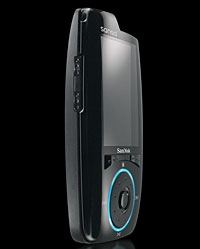 As well as wirelessly connecting to Yahoo’s Music service, the Connect supports MP3s and DRM WMAs provided by other services like Rhapsody, but you’ll have to get out Ye Olde cable to transfer the music from your desktop.
As well as wirelessly connecting to Yahoo’s Music service, the Connect supports MP3s and DRM WMAs provided by other services like Rhapsody, but you’ll have to get out Ye Olde cable to transfer the music from your desktop.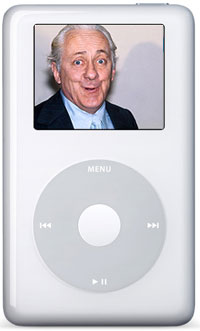 Yesterday, Apple announced that it had shifted its 100 millionth iPod, making it the fastest selling music player in the history of the known universe and quite possibly beyond.
Yesterday, Apple announced that it had shifted its 100 millionth iPod, making it the fastest selling music player in the history of the known universe and quite possibly beyond.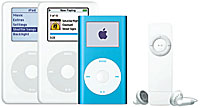 Never one to knowingly underhype his own products, Jobs continued; “iPod has helped millions of people around the world rekindle their passion for music, and we’re thrilled to be a part of that.”
Never one to knowingly underhype his own products, Jobs continued; “iPod has helped millions of people around the world rekindle their passion for music, and we’re thrilled to be a part of that.”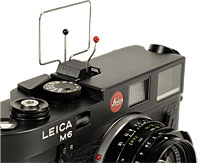 Photographers looking for a simple and effective way to quickly frame shots might like to swivel their snapping eyes in the direction of the Ikodot.
Photographers looking for a simple and effective way to quickly frame shots might like to swivel their snapping eyes in the direction of the Ikodot.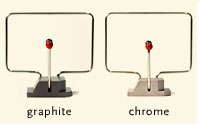 The user lines up the two balls to frame a photograph, with the lens coverage dictated by how close the finder is to your face.
The user lines up the two balls to frame a photograph, with the lens coverage dictated by how close the finder is to your face.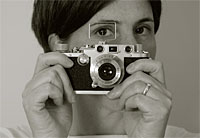 The Ikodot also offers advantages for four-eyed photographers who perhaps find it hard to focus on a LCD screen or get close up to an optical viewfinder. It’s a shame that the finder can’t fold flat when not in use though.
The Ikodot also offers advantages for four-eyed photographers who perhaps find it hard to focus on a LCD screen or get close up to an optical viewfinder. It’s a shame that the finder can’t fold flat when not in use though.